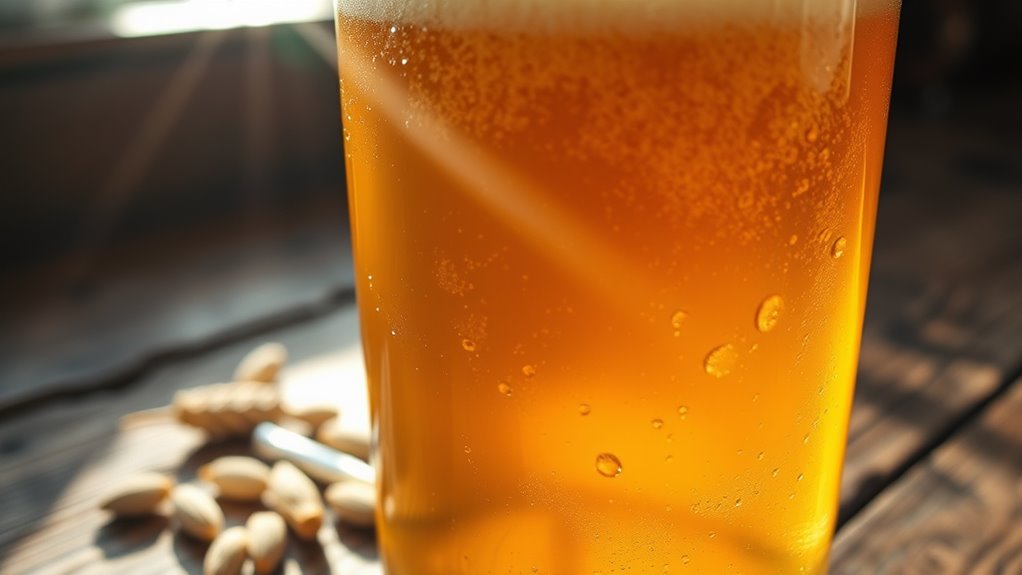
Beer offers a complex tapestry of flavors where bitter, sweet, salty, sour, and umami dance together. Depending on the style, you might encounter the bold hoppiness of IPAs or the rich sweetness of stouts. Malt provides a balancing sweetness and body, while hops add bitterness and enticing aromas, like citrus or floral notes. Yeast introduces unique fruity or earthy characteristics. Each sip reveals layers of flavor and mouthfeel that make you want to explore the intricacies further.
When you take a sip of beer, you're diving into a complex world of flavors that dance on your palate. Each beer tells its own story, shaped by its ingredients and brewing techniques, revealing layers of taste and aroma. Your experience begins with the five basic tastes: bitter, sweet, salty, sour, and umami. The interplay of these elements creates a fascinating flavor profile, varying widely among beer styles, from the hoppy bitterness of an IPA to the rich sweetness of a stout.
Malt plays an essential role in this symphony of flavors. As you savor a beer, you'll notice how the malt contributes sweetness and body, balancing the bitterness brought in by hops. This sweetness can manifest as caramel or toasted notes, enhancing the richness of your drink. You might even detect hints of coffee or chocolate in darker beers, where roasted grains lend a smoky aroma. Body is influenced by dextrins and proteins, which can add to the overall experience of the beer.
On the flip side, hops impart bold bitterness and distinctive aromas, often evoking citrus, floral, or herbal notes. The careful selection of hop varieties can elevate a beer's profile, making it invigorating or intensely flavorful.
Yeast also influences your tasting journey. Through fermentation, it contributes fruity or bread-like characteristics that round out the overall flavor. You might find yourself picking up on subtle notes of banana or clove in a wheat beer, or even a touch of earthiness in a farmhouse ale. The interaction between yeast and other ingredients is what elevates a good beer to a great one, adding complexity and intrigue.
As you continue to explore, the mouthfeel of the beer plays an important role in your overall experience. You'll notice how thickness, carbonation, and astringency can change your perception of the flavors. Some beers might feel light and crisp, while others may be thick and viscous.
Carbonation can enhance or mellow the sensation of bitterness, while temperature can further change how you perceive the beer's body. A cold lager may feel invigorating, whereas a room-temperature stout delivers a smooth, rich experience.
The finish and aftertaste are also essential components to reflect on. After swallowing, lingering flavors can either delight or disappoint. A satisfying finish might offer a pleasant dryness or a mouth-coating richness, while a less favorable aftertaste may leave you with lingering bitterness or an undesired off-flavor.
The balance of these lingering notes contributes greatly to your overall satisfaction with the beer.
In essence, beer is a multifaceted beverage that invites exploration. Each sip reveals the meticulous craftsmanship behind it, from the choice of ingredients to the brewing techniques employed. So the next time you raise a glass, take a moment to appreciate the intricate interplay of flavors, aromas, and textures that make beer such a beloved drink.
Conclusion
As you take that first sip, the crispness dances on your tongue like sunlight filtering through leaves, while rich malt undertones ground the experience, weaving a tapestry of flavors. Each gulp is a journey, where bitterness meets sweetness, and effervescence tickles your senses. It's a celebration of contrasts—refreshing yet complex, simple yet profound. Just like a sunset painting the sky in hues of gold and crimson, beer unfolds its story, inviting you to savor its layered depths.



